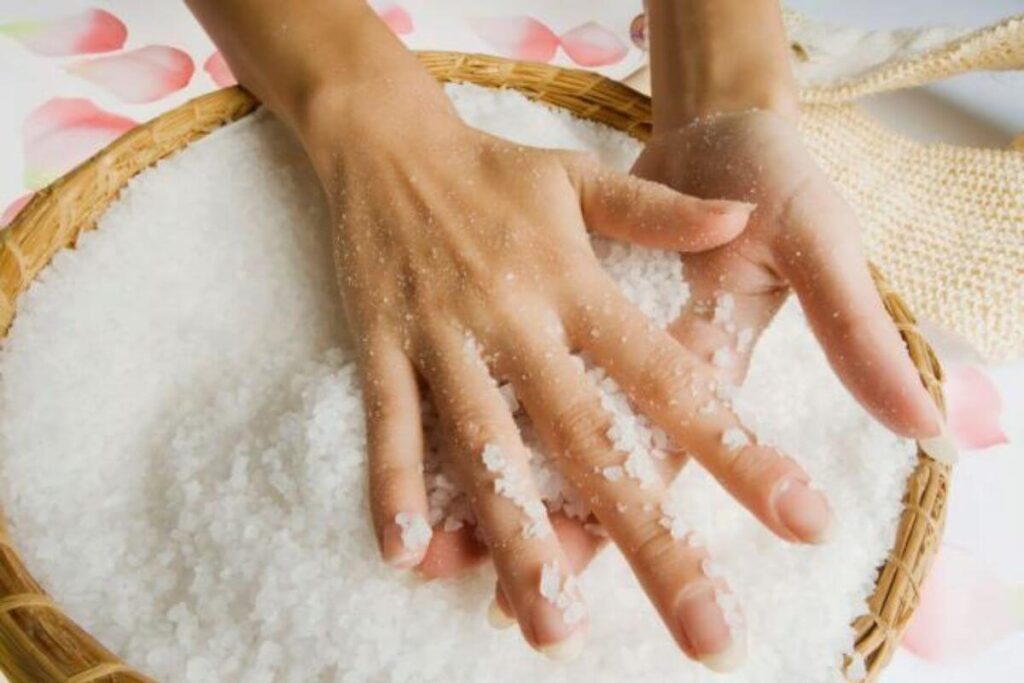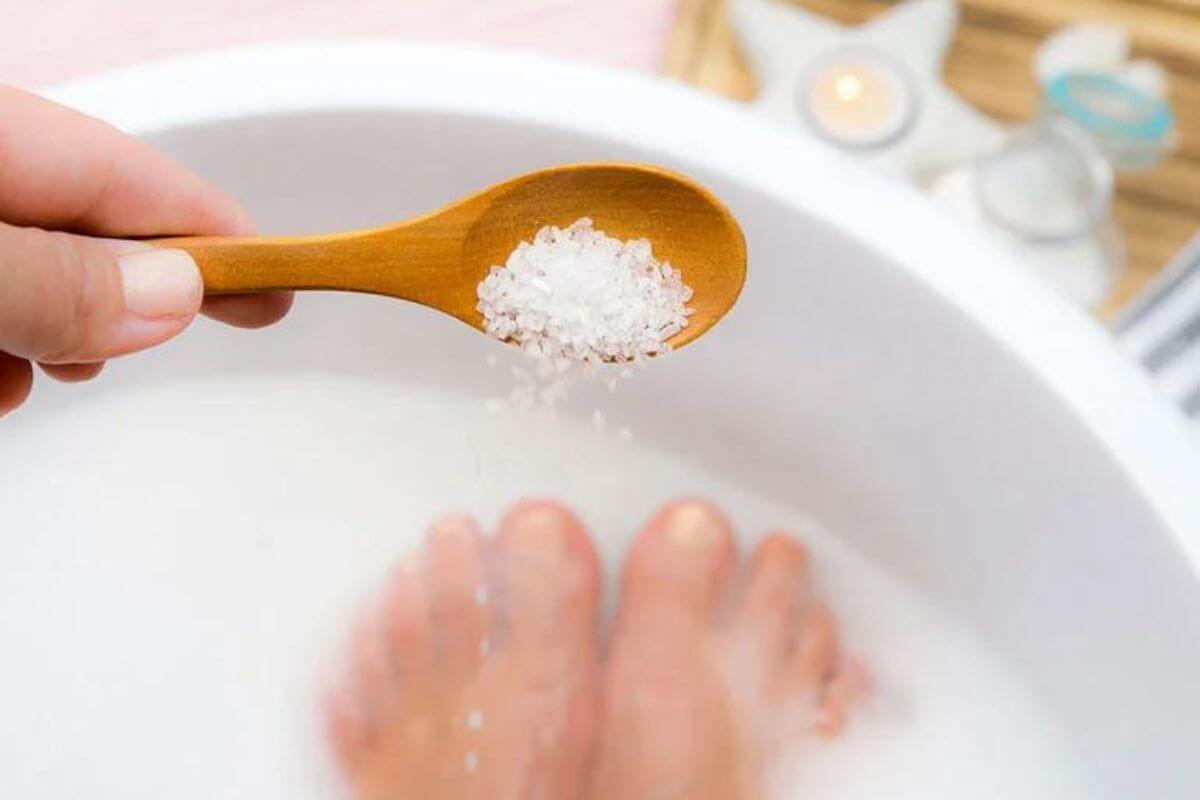A urinary tract infection (UTI) is a painful and uncomfortable condition that affects millions of people each year. UTIs are typically caused by bacteria entering the urinary system and can lead to a range of distressing symptoms, including a frequent urge to urinate, burning sensations, and abdominal discomfort. While the primary course of treatment for a UTI usually involves antibiotics prescribed by a healthcare professional, there is a growing interest in complementary approaches to alleviate the discomfort associated with UTIs. One such approach is the use of Epsom salt baths.
Understanding Epsom Salt
Epsom salt, also known as magnesium sulfate, is a chemical compound that has been used for centuries for its therapeutic properties. While it’s called “salt,” it’s different from the common table salt (sodium chloride) we use in cooking. Epsom salt contains magnesium and sulfate, which are believed to have various health benefits.

The Potential Benefits of Epsom Salt Baths for UTI
The use of Epsom salt baths for UTI is not a replacement for antibiotics, which are necessary to treat the underlying infection. However, Epsom salt baths can provide relief from some of the uncomfortable symptoms associated with a UTI. Here are some potential benefits:
1. Pain Relief:
Soaking in an Epsom salt bath may help alleviate the pain and discomfort associated with UTIs. The warm water and magnesium in Epsom salt can relax the muscles and provide a soothing effect.
2. Muscle Relaxation:
Epsom salt is known for its muscle-relaxing properties. This can be particularly helpful when UTIs cause muscle tension and spasms in the lower abdominal region.
3. Stress Reduction:
A warm bath with Epsom salt can have a calming effect on the mind, which can be beneficial for those experiencing the stress and anxiety often associated with UTIs.
4. Enhanced Hydration:
Soaking in warm water may encourage hydration, which is crucial for flushing out toxins and bacteria from the urinary system.
How to Take an Epsom Salt Bath for UTI Relief
Taking an Epsom salt bath for UTI relief is a straightforward process. Here are the steps:
Prepare the Bath:
Fill your bathtub with warm water. The water should be comfortably warm, not too hot.
Add Epsom Salt:
Add Epsom salt to the bathwater. The recommended amount is about 1-2 cups of Epsom salt, but you can adjust the quantity to your preference.
Dissolve the Salt:
Stir the water to help dissolve the Epsom salt fully.
Soak:
Soak in the Epsom salt bath for about 15-20 minutes. Relax, breathe deeply, and let the warm water and magnesium work their magic.
Rinse:
After your soak, gently rinse off with clean water to remove any residual salt on your skin.
Hydrate:
Drink a glass of water to stay hydrated, as the warm bath may cause you to sweat and lose fluids.
Caution and Consultation
While Epsom salt baths can be a soothing complement to UTI treatment, they are not a substitute for antibiotics or professional medical advice. If you suspect you have a UTI, it’s crucial to consult a healthcare provider for diagnosis and appropriate treatment.
Moreover, some individuals may be sensitive or allergic to Epsom salt, so it’s advisable to do a patch test before using it in a full bath.
In Conclusion
Epsom salt baths can provide a welcomed reprieve for individuals suffering from the discomfort of a UTI. The warm water and magnesium in Epsom salt can offer pain relief, muscle relaxation, and stress reduction. However, they should always be used as a complementary method to conventional treatment, not as a replacement. It’s important to consult a healthcare professional for a proper diagnosis and antibiotic treatment when dealing with a UTI.
UTI Prevention and Additional Tips
While Epsom salt baths can be a soothing and complementary approach to UTI relief, it’s equally important to consider strategies for UTI prevention and other tips to manage the condition effectively:
1. Stay Hydrated:
One of the most effective ways to prevent UTIs is to maintain proper hydration. Drinking an adequate amount of water helps flush bacteria from the urinary system. Aim for at least eight glasses of water per day.
2. Urinate Regularly:
Don’t hold in urine for extended periods. Urinating regularly helps expel bacteria from the urinary tract.
3. Wipe Properly:
When using the restroom, always wipe from front to back to avoid introducing bacteria from the anal area to the urethra.
4. Wear Breathable Clothing:
Choose cotton underwear and avoid tight-fitting pants. Breathable fabrics help reduce moisture and promote a healthier environment for the urinary tract.
5. Practice Good Hygiene:
Keep the genital area clean and dry, and use gentle, unscented soaps for washing.
6. Avoid Irritants:
Steer clear of irritating feminine hygiene products, douches, and strong fragrances that can disrupt the natural balance of the urinary tract.
7. Cranberry Products:
Some studies suggest that cranberry products may help prevent UTIs, as they contain compounds that may prevent bacteria from adhering to the urinary tract.
8. Probiotics:
Consider incorporating probiotic-rich foods or supplements into your diet. Probiotics can help maintain a balanced microbiome, which may support urinary health.
9. Consult a Healthcare Provider:
If you frequently experience UTIs, consult with a healthcare provider. They can assess your situation and may recommend preventive measures or treatment options.
The Bottom Line
Epsom salt baths can be a comforting addition to your UTI management routine, offering relief from discomfort and muscle tension. However, they should be viewed as a complement to, not a replacement for, prescribed antibiotic treatment from a healthcare professional.
Preventing UTIs and managing the condition effectively involve a combination of good hygiene practices, proper hydration, and, in some cases, dietary adjustments. If you suspect a UTI or are prone to recurrent UTIs, consulting a healthcare provider is essential to ensure proper diagnosis and treatment. A holistic approach, which may include Epsom salt baths, can help make the journey to recovery more manageable and soothing.
FAQs
1. Can Epsom salt baths cure a UTI?
No, Epsom salt baths cannot cure a UTI. UTIs are bacterial infections that require antibiotics prescribed by a healthcare professional for treatment. Epsom salt baths can provide relief from some UTI symptoms but should be used as a complementary approach, not a replacement for antibiotics.
2. How much Epsom salt should I add to my bath for UTI relief?
A typical recommendation is to add about 1-2 cups of Epsom salt to your bath for UTI relief. However, you can adjust the quantity to your preference. Ensure the salt is fully dissolved in warm water before soaking.
3. How long should I soak in an Epsom salt bath for UTI relief?
A recommended soaking time is approximately 15-20 minutes. This allows the warm water and magnesium in Epsom salt to provide relief from pain and muscle tension associated with UTIs.
4. Can Epsom salt baths prevent UTIs?
Epsom salt baths are not a preventive measure for UTIs. Preventing UTIs primarily involves good hygiene practices, staying hydrated, and urinating regularly. While Epsom salt baths can offer relief, they are not a proven method for UTI prevention.
5. Are Epsom salt baths safe for everyone with a UTI?
Epsom salt baths are generally safe for most people with UTIs. However, it’s advisable to perform a patch test before using them in a full bath to ensure you are not sensitive or allergic to Epsom salt. Additionally, always consult a healthcare provider for diagnosis and appropriate antibiotic treatment when dealing with a UTI.
These FAQs aim to provide clarification on the use of Epsom salt baths for UTI relief and their limitations in treating or preventing UTIs. It’s essential to use Epsom salt baths in conjunction with proper medical care and preventive measures for the best outcomes.



